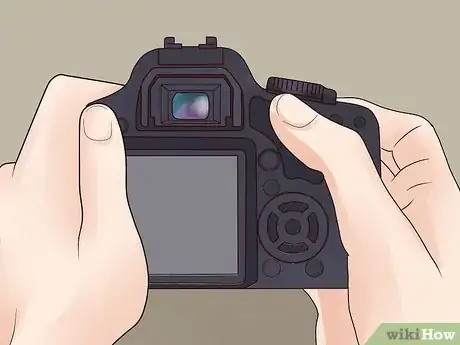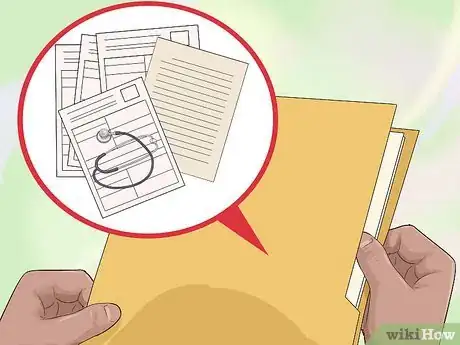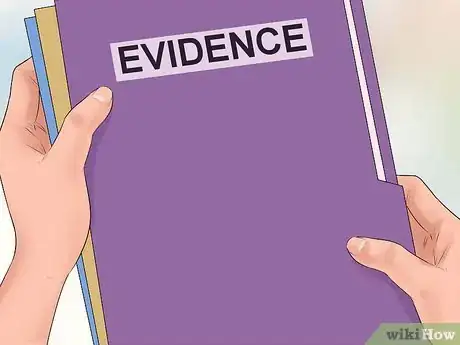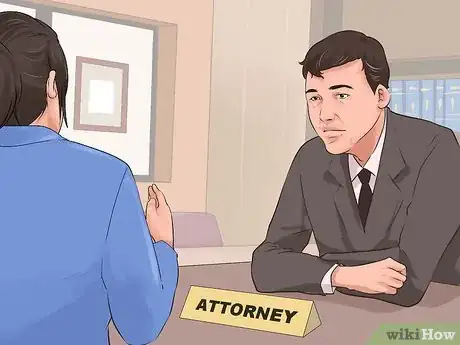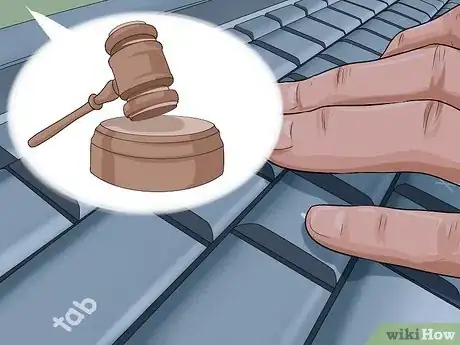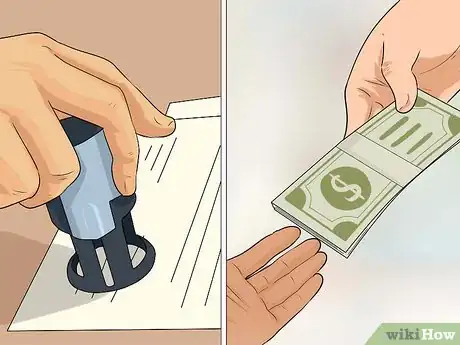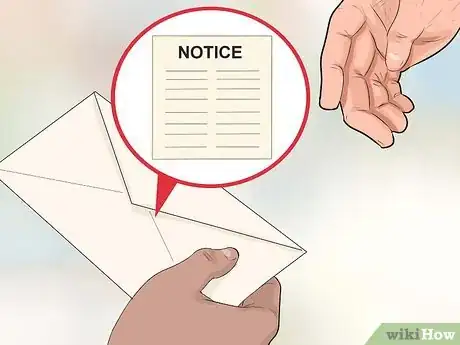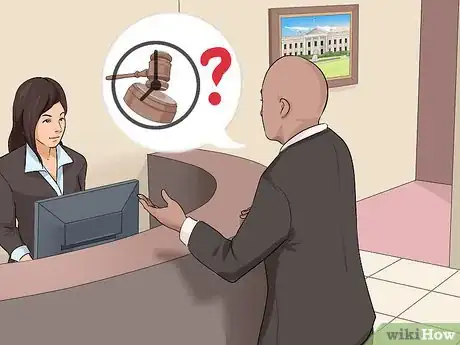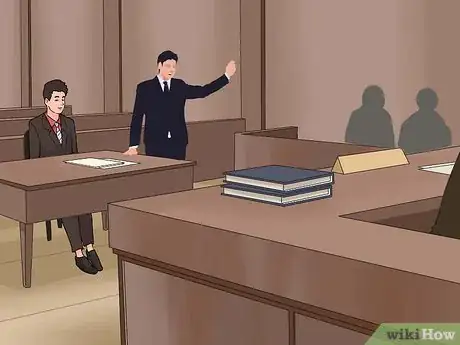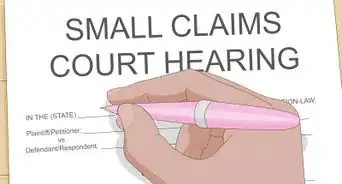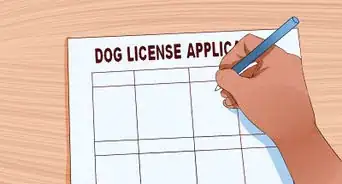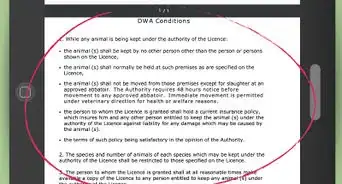This article was co-authored by Clinton M. Sandvick, JD, PhD. Clinton M. Sandvick worked as a civil litigator in California for over 7 years. He received his JD from the University of Wisconsin-Madison in 1998 and his PhD in American History from the University of Oregon in 2013.
There are 18 references cited in this article, which can be found at the bottom of the page.
This article has been viewed 37,602 times.
Any injury to your pet can be emotionally traumatic. Many people consider their pets to be like children. Fortunately, you can receive compensation for any injury done to your pet, including any injury that leads to death.[1] Before bringing a lawsuit, you should meet with a lawyer to discuss your state’s law as well as the strength of your case.
Steps
Gathering Evidence for Your Lawsuit
-
1Document the injury to your pet. You need evidence of the injury or death in order to bring a successful lawsuit. If your pet is injured, you will also want to get immediate treatment. Although you may be in shock, you should move quickly and do the following:
- Call the vet or take your pet to the vet.[2] Your pet’s health should be your first priority, so get her treatment immediately. The vet can treat your pet and also document the extent of the injury. Be sure to leave the vet’s office with a copy of your pet’s record that shows the injury.
- Take your pet to the vet even if she is already dead. The vet can perform an examination to determine the cause of death. This report will be helpful later on during a lawsuit.[3]
- Take photographs. You can also take color photographs that show the injury. If your pet was killed, take photographs of the animal where you found him or her.[4] Someone can take photographs for you if you are too emotional.
-
2Identify witnesses. If someone saw your pet get injured or killed, then you should try to get their name and contact information.[5] You might need to call them later if you go to trial.
- The person who injured your pet is also a witness. You should write down whatever they say. A defendant’s statements can be used against him or her at trial.
Advertisement -
3File a police report. You should also call the police and report whoever injured or killed your pet. The police will investigate and then fill out a police report.
- You should also call the police if you don’t know who killed or injured your pet. Unfortunately, you need to know this person’s identity before you can sue. In every lawsuit, you need to name a defendant. If you don’t know who harmed your pet, perhaps the police can find out by performing an investigation.
- It is a crime if someone intentionally kills your animal, so always call the police if someone intentionally kills your pet. In most states, the prosecutor will charge the defendant with animal cruelty. The judge will also order the defendant to pay you compensation.[6]
-
4Determine the value of your pet. The amount you will be compensated may depend in part on how much you paid for your pet. Try to find evidence of how much you paid for your pet.
- For example, if you adopted the pet and paid an adoption fee, then you will need to find the receipt for that fee. If you purchased your pet from a breeder, then a copy of the check that you wrote or a receipt from the breeder can serve as proof of payment.
- Keep in mind that the amount you will be compensated may be more or less depending on the amount that you paid for your pet. For example, an expensive show dog will require more compensation than a dog that you adopted from an animal shelter.
-
5Hold onto all bills paid to treat the animal. You can be compensated for money you spent getting your pet medical treatment.[7] Accordingly, you should hold onto your veterinarian bills and any receipts for medicines or supplies that you purchase.
- To help you stay organized, you should set aside a folder which can hold your bills. As soon as you get home, you can throw your receipts in the folder. When you get ready to sue, you can sit down and add up the amount you spent on treatments.
-
6Gather evidence of your relationship with your pet. You might be able to get compensated for the “sentimental” value of your pet. This sentimental value includes your loss of companionship with the pet. You can help prove your special relationship by gathering the following:[8]
- photographs of you and your pet together
- witness testimony about how important the pet was to you and your family
-
7Document your emotional suffering. You may also be able to get compensation for the emotional harm of watching your pet be injured. This will depend on your state law.[9] You should document the emotional pain that your pet’s death has caused you.
- As soon as possible after you discover your pet’s condition, you should sit down and write down how you are feeling. Be honest. This documentary evidence can come in handy when you sue.
- In particular, you should document the shock that you felt at coming upon your dead pet’s body or seeing someone attack your pet.
- Also describe any ongoing depression that you feel. You can keep a daily journal, if you want, in which you explain your emotional distress and continued feelings of grief.
-
8Identify other compensation. In addition to getting compensated for veterinarian bills and emotional distress, you may be able to get other compensation, depending on your state:[10]
- The market value of the pet. If your cat is killed, for example, then you can get compensation for how much it would cost to buy another cat. This amount is calculated based on your pet’s breed, age, health, and other factors.
- Punitive damages. In some states, a judge can award you “punitive damages” if you win your lawsuit. Punitive damages are meant to punish the defendant for particularly bad conduct such as intentionally killing your pet.
-
9Meet with an attorney. You should meet with an experienced attorney to discuss your case.[11] You do not have to hire the lawyer, but you need an experienced lawyer to evaluate your case. The lawyer can advise you about whether or not you want to sue.
- To find a qualified lawyer, you should contact your local or state bar association, which should offer attorney referrals.
- Once you have the name of a lawyer, you can call and schedule a half-hour consultation. Most lawyers offer these for free or for a reduced price.
- Be sure to discuss with the lawyer other ways of resolving your dispute. Lawsuits are expensive and your pet’s injury might only have cost $200 to treat. You might pay that much just to file a lawsuit. You should talk with your lawyer about different ways you could settle the dispute outside of court.
Filing the Lawsuit
-
1Find the right court. You must sue the defendant in the county where he or she lives or in the county where the death or injury took place. If the person lives in the same county as you, then you will sue in your county court.
- You should also think about suing in small claims court. These courts are set up so that you don’t need a lawyer. If you can’t afford a lawyer, then you should sue in small claims court.
- Small claims courts only handle disputes below a certain amount. This amount will differ depending on your state. Generally, the maximums are between $5,000 and $10,000.[12] If you want to sue for more than your state’s maximum, you will have to sue in regular civil court.
-
2Ask for a complaint form. You start the lawsuit by drafting and filing a complaint. This legal document identifies you and the defendant and also explains to the judge what happened. In your complaint, you also state how much compensation you want the judge to give you.[13]
- Your lawyer can draft the complaint. However, if you don’t have a lawyer, then you should stop into the court and ask if they have a “fill in the blank” complaint form for you to use.
-
3Complete the complaint. Be sure that your information is legible. You should use a typewriter if you have to. Each complaint form differs slightly. However, they each will generally ask for the same information:[14]
- Your name and contact information.
- The name and contact information for the defendant.
- How much money you want the court to give you.
- A description of what the defendant did. In particular, explain the defendant’s actions. Also describe the injury your animal suffered.
- For example, “The defendant backed up his Ford F-150 down the driveway. My dog ran toward the truck, barking. The defendant did not stop or look over his shoulder. Instead, he accelerated down the driveway, running over my dog, which died instantly.”
-
4File your complaint. Make multiple copies. You will keep one for your records and send one copy to the defendant. If there is more than one defendant, then each defendant gets a copy. Take all of your copies and the original complaint to the court clerk. Ask to file.
- The clerk should stamp all of your copies with the date. This will help show that you filed the original.
- You will probably have to pay a filing fee to start the lawsuit. If you can’t afford the fee, then ask for a fee waiver form and complete it.
-
5Serve the complaint. Before you go to trial, you will also need to serve the complaint against the defendant. The complaint will have to be served to the defendant along with an official "Summons" to appear in court. The defendant will then need to respond with an "Answer."
- Generally, the Summons can be served in a few ways. For example, you can pay the sheriff or a private process server to make service on the defendant.[15] Each service will cost around $50.
- You could also have someone 18 or older serve notice, provided he or she is not part of the lawsuit.[16]
- You are not allowed to make service.
- Whoever makes service should fill out a “proof of service” form and return it to you. You then need to file it with the court.[17] Keep a copy for your own records.
Going to Trial
-
1Engage in discovery. After the defendant has entered his plea or pleas, both parties will need to engage in the process of discovery. This phase of the trial includes giving statements under oath, gathering witness testimonies, and collecting other types of evidence to use during the trial.
- For example, you may need to get a statement from your pet's veterinarian, collect veterinary records, gather receipts, and gather other types of evidence that can help to prove your position in court.
-
2Get your evidence in order. If you are representing yourself in court, then you will need to gather the evidence you gathered during the discovery phase before the trial. Typically, your evidence will consist of witness testimonies and other documents.
- Know what you need to prove. Generally, you will need to prove that the defendant either intentionally harmed your pet or “negligently” did.[18] Negligence means that the defendant didn’t exercise proper care around your pet. For example, if the defendant backed over your dog, then he might not have shown sufficient care if he didn’t look in his rearview mirror.
- Line up your witnesses. You will have to give the defendant a list of witnesses you intend to call. These witnesses must have relevant, personal knowledge. This means they can’t testify as to what someone told them or to rumors.
- Send subpoenas to witnesses. Tell your witnesses when the trial is being held. If you are afraid they won’t show, then get a subpoena from the court clerk and have it served on each witness. A subpoena is a legal command to attend trial and give testimony.[19]
- Prepare exhibits. You can introduce helpful documents as exhibits. For example, the vet’s report which shows the cause of death or the extent of injury is a great exhibit. To turn a document into an exhibit, make sure it is free of any handwriting or notes. Then put an “exhibit sticker” on it. You can get exhibit stickers from an office supply store or from the court clerk.[20]
-
3Consider the possibility of a summary judgment. If you do not have adequate evidence to go to trial or if your evidence is not substantial enough to indicate that you will be successful, then the case may be subject to summary judgment. This is when all or part of your case is thrown out and will not be considered in court.[21]
- A summary judgment is not always a bad thing. In fact, it may be to your advantage if your evidence is lacking.
-
4Arrive on time. You don’t want to be late to your trial. If you are, the judge could dismiss it. You should try to arrive with 15-30 minutes to spare. You will need to find parking and go through any security at the courthouse.
- You should check in with the court clerk when you arrive. You may need to sign in.
- Make sure to turn off all electronic devices (including cell phones) before entering court.
- Also throw away all food and drinks, as they are not allowed in court.[22]
-
5Make an opening statement. A trial begins with each side making an opening statement. You should treat the opening statement as a roadmap for the evidence that you will present. Make sure to tell the judge the highlights of what the testimony will be.
- In small claims court, the trial might be more informal than in regular civil court. However, you will probably still need to summarize your case in at least a few sentences so that the judge can understand the dispute.
- For example, you should tell the judge the injury to your pet and what evidence will show the defendant committed the injury. You could say, “As the evidence will show, the defendant visited my house on July 2, 2016. As he was pulling out of my driveway, my dog ran up to his truck. And as the evidence will further show, the defendant did not slow down or look in the rearview mirror. Instead, he ran over my dog.”
-
6Call your witnesses. Because you are bringing the lawsuit, you will go first. Your lawyer should call your witnesses and ask them questions. For example, you will probably want your vet to testify as to the extent and cause of the injury.
- If you are handling questions on your own, then remember not to ask “leading questions.” A leading question suggests its own answer and can usually be answered “yes” or “no.”
- For example, “The dog was dead when I brought him in to you, isn’t that correct?” is a leading question. Instead, you should ask open-ended questions, like the following:
- “What is your profession?”
- “How long have you been a vet?”
- “Where were you on July 2, 2016?”
- “Did someone stop in?”
- “What condition was the dog in?”
-
7Testify on your behalf. You also will probably testify. If you saw the defendant injure your pet, then you can testify to that fact. If you are claiming emotional distress, then you will need to testify as to how the injury affected you emotionally. Your lawyer can ask you questions and then the defendant’s lawyer will cross-examine you. If you have no lawyer, then you will give your testimony in the form of a speech.
- You should speak confidently and directly. Don’t drag your feet if the defendant’s lawyer asks you an uncomfortable question. For example, if the defendant asks if you ever tied your dog up, don’t stall. Instead, say, “No” if that’s the answer.
- If you find yourself getting emotional, then ask the judge if you can take a short break.
- Don’t get rattled on cross-examination and don’t argue with the defendant’s lawyer or the judge.[23] Instead try to stay calm.
- Always listen closely to the question and ask for clarification if you need it. Don’t guess if you don’t understand the question.[24]
-
8Cross-examine the defendant’s witnesses. The defendant can present evidence after you. Your lawyer will be able to ask the defendant’s witnesses questions on cross-examination.
- If you are representing yourself, then see Question Witnesses when Representing Yourself for tips on cross-examination.
-
9Watch for opportunities to settle. Many civil suits settle before the trial is over. The person you are suing may want to work out an arrangement to pay damages and this would be called a settlement.[25]
- Keep in mind that you do not have to agree to the terms of a settlement until you are happy with them. Settlement conferences may take place early on and later in the trial process.[26]
-
10Deliver your closing argument. At the end of the trial, you will make a closing argument. The purpose is to tie together all of the evidence and show how it proves that the defendant injured or killed your pet.
- Always remind the judge of specific pieces of evidence. If you refer to a document, then have the document or photograph in your hand.
- For example, you can argue, “I introduced this veterinarian report earlier. Dr. Miles said it represented his opinion about the dog’s death. “Blunt force trauma” is what the report says. On the stand, Dr. Miles gave his opinion that the force was consistent with being run over by a truck.”
-
11Wait for the verdict. The judge may deliver the verdict immediately after all evidence has been presented. However, if your case is especially complicated, then the judge might take the case under consideration and issue a ruling later.
- If you lose the lawsuit, then you might be able to bring an appeal. You should talk this over with a lawyer.
- If you want to appeal, then you do not have a lot of time to file your Notice of Appeal form. Most states give you less than 30 days from the date the judgment becomes final. In some states, like Missouri, you have fewer than 10 days.[27]
References
- ↑ http://blogs.findlaw.com/injured/2013/08/can-you-sue-over-injuries-to-your-pet.html
- ↑ https://aldf.org/article/what-to-do-when-your-companion-animal-has-been-injured-or-killed/
- ↑ https://aldf.org/article/what-to-do-when-your-companion-animal-has-been-injured-or-killed/
- ↑ https://aldf.org/article/what-to-do-when-your-companion-animal-has-been-injured-or-killed/
- ↑ https://aldf.org/article/what-to-do-when-your-companion-animal-has-been-injured-or-killed/
- ↑ https://aldf.org/article/damages-for-death-or-injury-of-an-animal/
- ↑ http://www.nolo.com/legal-encyclopedia/free-books/dog-book/chapter9-6.html
- ↑ https://aldf.org/article/damages-for-death-or-injury-of-an-animal/
- ↑ http://www.legalmatch.com/law-library/article/can-i-sue-for-the-injury-or-death-of-my-pet.html
- ↑ http://www.legalmatch.com/law-library/article/can-i-sue-for-the-injury-or-death-of-my-pet.html
- ↑ http://blogs.findlaw.com/injured/2013/08/can-you-sue-over-injuries-to-your-pet.html
- ↑ http://www.nolo.com/legal-encyclopedia/small-claims-suits-how-much-30031.html
- ↑ http://nationalparalegal.edu/public_documents/courseware_asp_files/researchLitigation/PreTrialPractice/Summons.asp
- ↑ http://courts.ky.gov/resources/legalforms/LegalForms/175.pdf
- ↑ http://www.nolo.com/legal-encyclopedia/free-books/small-claims-book/chapter11-4.html
- ↑ http://www.nolo.com/legal-encyclopedia/free-books/small-claims-book/chapter11-4.html
- ↑ http://www.nolo.com/legal-encyclopedia/free-books/small-claims-book/chapter11-4.html
- ↑ https://aldf.org/article/what-to-do-when-your-companion-animal-has-been-injured-or-killed/
- ↑ http://www.selegal.org/Self-Help/Booklets/HOW%20TO%20PREPARE%20BOOKLET.pdf
- ↑ http://www.courts.ca.gov/partners/documents/shc-1084.pdf
- ↑ http://uk.practicallaw.com/6-204-3085
- ↑ http://www.selegal.org/Self-Help/Booklets/HOW%20TO%20PREPARE%20BOOKLET.pdf
- ↑ http://www.selegal.org/Self-Help/Booklets/HOW%20TO%20PREPARE%20BOOKLET.pdf
- ↑ http://www.selegal.org/Self-Help/Booklets/HOW%20TO%20PREPARE%20BOOKLET.pdf
- ↑ http://www.americanbar.org/groups/public_education/resources/law_related_education_network/how_courts_work/cases_settling.html
- ↑ http://thelawdictionary.org/article/what-happens-during-a-settlement-conference/
- ↑ https://www.courts.mo.gov/page.jsp?id=28374
